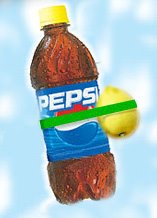Between A Pepsi And A Lemon Juice

Now I think I get it. Now I think I know the reason for the two news stories about the hazardous goods crossing the Ambassador Bridge. It was when I read the story about the Star being nominated for all of those newspaper awards that it all started to become clear to me.
Here is what was said:
"[Windsor Star executive editor Marty] Beneteau credited the news team for helping to bring about positive change through its coverage of the Lori Dupont slaying at Hotel-Dieu Grace Hospital.
"I think we can take partial credit into calling an inquest into the nurse's slaying," Beneteau said. "We did things that newspapers can do to bring about change, positive change. I think we got a lot of results this year and this now validates the results we got."
So shall we insert "Ambassador Bridge" in place of "Lori Dupont" to explain the coverage? Is the Star on another mission to change things, like building a public bridge perhaps?
I was pretty worried when I read the Star story about Alum being transported across the Ambassador Bridge. There it was in black and white..."When concentrated aluminum sulfate comes into contact with water it can cause the formation of sulfuric acid." We were told it was "highly corrosive." I could just picture in my mind what would happen if there was a spill.
But then something did not make sense. The alum was being delivered to Windsor's Lou Romano Water Reclamation Plant. Why would the City use a chemical in its Water plant that would turn into "highly corrosive" sulphuric acid when it touched water and presumably could cause major damage to the plant. I wondered as well where this sulphuric acid was being dumped too. The more I thought about the consequences, the more worried I became.
I picked up the phone and did a bit of investigation and found the following:
Here is some information on Liquid Aluminum Sulfate “alum”
1. Alum is considered GRAS “Generally Recognized As Safe”
2. Alum has been used to purify potable water for over 2,000 years.
3. Alum became the potable water purification product of choice in Canada and the US in the 1880’s
4. Alum added to water does not form sulfuric acid. It forms aluminum hydroxide which is a coagulant that removes fine particles and sediments from potable water.
5. Alum is used in clean water treatment plants to remove phosphates. This prevents algae blooms in the streams, rivers, or lakes where the purified water is discharged. So it is very important to maintaining healthy ecosystems.
6. Alum is used in lakes to remove phosphates which controls algae and restores the lake for fishing, recreation, and potable water uses. We have an application that used 14 million pounds of alum on an 1100 acre lake. The application was approved at the federal, state and local levels.
7. Alum is used in foods, for example, pickles.
8. Alum is used in cosmetics and antiperspirants.
9. Alum is used medicinally to stop bleeding from minor cuts and abrasions.
10. Alum is shipped with placards only because it is slightly corrosive.
11. If alum is spilled it is easily cleaned up with water.
The credentials of the person who gave me this information, a Water Chemist, included degrees in chemistry and biology with twenty-nine years experience in water treatment chemistry including five international patents.
That did not satisfy me however. I needed to know more. Another source told me that product similar to what the City receives "has a pH value (measure of acidity) somewhere between a Pepsi Cola and lemon juice. Obviously any dilution by the addition of water would reduce that acidity."
I thought I could rest easy now. I felt comfortable that the Bridge could handle a spill from a can of Lemon Pepsi!
I wondered if Mr. Beneteau would nominate me for an Investigative "Blogger" award. Better yet, I wonder if the Windsor Star will correct the facts and quell the tempest in a soda can that they initiated? And what about the ‘pickle’ created for willing politicians by Alum-scam? Stay tuned, dear readers – but don’t hold your breath!”


<< Home